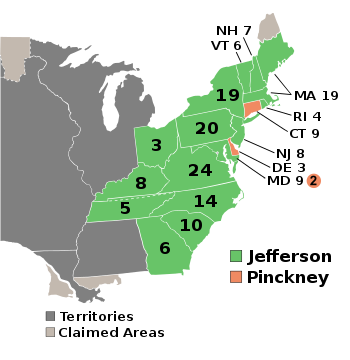U.S. presidential election, 1804
|
|
|||||||||||||||||||||||||||||
|---|---|---|---|---|---|---|---|---|---|---|---|---|---|---|---|---|---|---|---|---|---|---|---|---|---|---|---|---|---|
|
|||||||||||||||||||||||||||||
|
All 176 electoral votes of the Electoral College 89 electoral votes needed to win |
|||||||||||||||||||||||||||||
|
|||||||||||||||||||||||||||||

Presidential election results map. Green denotes states won by Jefferson, burnt orange denotes states won by Pinckney. Numbers indicate the number of electoral votes allotted to each state.
|
|||||||||||||||||||||||||||||
|
|||||||||||||||||||||||||||||
Thomas Jefferson
Democratic-Republican
Thomas Jefferson
Democratic-Republican
The United States presidential election of 1804 was the fifth quadrennial presidential election, held from Friday, November 2, to Wednesday, December 5, 1804. It pitted incumbent Democratic-Republican President Thomas Jefferson against Federalist Charles Cotesworth Pinckney of South Carolina, a hero of the American Revolutionary War and former Ambassador to France. Jefferson easily defeated Pinckney and George Clinton was elected vice president. Clinton went on to serve under both Jefferson and his successor, James Madison.
The presidential election of 1804 was the first one conducted following the ratification of the Twelfth Amendment to the United States Constitution, which reformed procedures for electing presidents and vice presidents. Under the rules of the Twelfth Amendment, presidential electors were required to specify their choice for president and vice president on their ballots; previously, electors voted only for president, with the person who came in second becoming the vice president.
Jefferson's 45.6 percentage point victory margin in the popular vote remains the highest victory margin in a presidential election in which there were multiple major party candidates. With this election, Jefferson became the first former vice president in American history to be elected and re-elected president, a feat that has since been repeated only once, by Richard Nixon in 1968 and 1972.
...
Wikipedia


